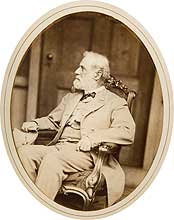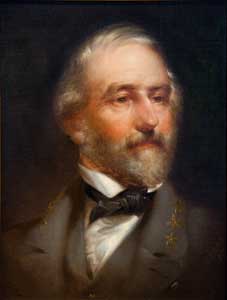General Robert Edward Lee
commander, Army of Northern Virginia
Robert Edward Lee was born on January 19, 1807 at "Stratford" in Westmoreland County, Virginia, to Henry and Anne Hill Lee. Henry Lee was a distinguished cavalry officer who participated in the American Revolution where he gained the nickname "Light Horse Harry". Due to declining political prospects and financial problems, the elder Lee moved his family from Stratford to a home in Alexandria, Virginia on the Potomac River across from Washington. Robert E. Lee was raised there, attended school and enjoyed outdoor activities along the river. In 1825, the young Lee secured an appointment to West Point where he excelled in his studies and in the military exercises. Appointed adjutant of the cadet corps, he graduated in the number two position of his class in 1829.
As a young second lieutenant, Lee served on many army outposts and at several army forts. Lieutenant Lee married Mary Ann Randolph Custis, a direct descendent of Mary Washington, in 1831. The couple had seven children. Lee was home only briefly as he was assigned to engineer many projects in the midwest and around Washington. With the outbreak of hostilities with Mexico, Lee was assigned duty with the army and fought in many battles under General John E. Wool and General Winfield Scott. Slightly wounded at the Battle of Chapultepec, Lee distinguished himself during the war and received several promotions in rank after the war ended. In the 1850's, he briefly served as the superintendent of West Point and then went on to a command in the 2nd US Cavalry.
In 1859, Lee took part in a dramatic event that contributed to the growing division between North and South. By chance he was in Washington when the radical abolitionist John Brown and a small band of followers raided the United States Arsenal at Harper's Ferry, Virginia, seizing weapons and hostages with the objective to spark an uprising among slaves in Virginia. Lee was immediately sent with his troops to Harper's Ferry, where they eventually cornered Brown in the arsenal engine house and took him prisoner after a bloody shoot out. Within a year, the talk of secession had become stronger throughout the south. As an army officer, Lee was against secession and never entertained the idea of a revolt against the government to which he had sworn an oath. Only if Virginia would secede would he then have to make a decision.
Lee continued his work in Washington, living at his wife's ancestral home at Arlington. In 1861, the south did secede and Virginia soon followed. Lee was offered a command in the Union Army but declined to accept the assignment because of his ancestry and loyalty to Virginia. It was a difficult decision for Lee to give up his career and his country, but his personal allegiance was to his family and his roots that were in Virginia. With some regrets, Lee resigned his commission and moved his family to Richmond, never see the home at Arlington again. Lee offered his services to the state of Virginia and was placed in command of all military forces from that state. He was later assigned as personal military advisor to President Jefferson Davis, which was a very difficult job. Lee had to coordinate numerous operations involving officers who were very sensitive about their command positions and obligations. It was a difficult time for him and Lee suffered the brunt of heavy criticism.
In the spring of 1862, the Union Army of the Potomac commanded by General George McClellan was poised to strike the city of Richmond. In a pitched battle at Seven Pines, General Joseph Johnston, commanding the Confederate forces, was seriously wounded. Lee was immediately assigned to replace Johnston and he took command of the army, which he renamed the Army of Northern Virginia. Despite some early difficulties, General Lee undertook the new assignment with vigor and spirit. Co-ordinating his troops near Richmond with those of General "Stonewall" Jackson in the Shenandoah Valley, Lee met the Union threat on two fronts. Quickly driving back Union forces in the Valley, General Jackson rushed his troops to Richmond and joined with General James Longstreet's Corps in attacking McClellan's army. Together, Lee and his officers were able to throw back the Union threat during the Seven Days Battles.
What followed was a set of victories against seemingly insurmountable odds. General Lee's army was always outnumbered, out gunned, and often in a poor position to attack or defend. Yet General Lee was a practical strategist with an engineer's sense, who was willing to take risks to outmaneuver his opponents. The support of excellent commanders contributed to repeated victories against the Union Army again and again. Lee suffered several setbacks during the Maryland Campaign in 1862, which resulted in the Battle of Antietam. Still, Lee's thin line held most of the battlefield at the end of a single day of fighting, giving him a strategic victory, though one he could not take advantage of. He was forced to retreat across the Potomac River and back to Virginia. After the Battle of Fredericksburg that December, Lee spent the winter rebuilding his battered army. The Union Army rebuilt itself as well and opened the spring of 1863 with a surprise move against Lee's forces. The Battle of Chancellorsville, Virginia turned out to be Lee's greatest victory, but at a very high cost when "Stonewall" Jackson, his most trusted officer, was mortally wounded. Despite the loss of his beloved corps commander, Lee carried on and invaded the North once again. His troops successfully marched through Maryland and southern Pennsylvania until they came together at Gettysburg. The Battle of Gettysburg was a costly defeat for the Army of Northern Virginia and Lee felt a great personal responsibility for the loss, but the Confederate government displayed great confidence in the commander of so many men and refused to allow him to resign.
General Lee faced a new antagonist in the spring of 1864. After a succession of Union victories in Tennessee and Mississippi, General Ulysses S. Grant arrived in Washington where President Lincoln placed him in overall command of Union land forces. Knowing that Lee must be defeated to end the war, Grant chose to make his headquarters with the Army of the Potomac in Virginia where his challenge with Lee in a strategic duel began in the spring of 1864 in the "Overland Campaign", also known as the "Wilderness Campaign" by its participants. Starting with the Battle of the Wilderness, May 5-7, 1864, the two armies grappled continuously for many weeks through middle Virginia and the fighting was bitter and brutal. Lee was able to block every maneuver Grant made and though Lee's forces inflicted heavy losses on the Union army, he knew that time was running out for his own. His losses could not be easily replaced, material shortages became more acute, and, despite his best efforts, Grant had succeeded in continually marching Meade's Union army southward, right to the outskirts of Richmond, where Lee also had to contend with the Union Army of the James.
In mid-June, General Grant shifted his forces around Richmond to Petersburg, Virginia, an important junction for southern railroads through the Carolinas into southern Virginia. Once again, Lee's army arrived in the city to halt the Union attacks. Trenches and forts were constructed by both armies, and the battle became a siege of the city. In an attempt to break this stalemate, Lee sent part of his army northward to invade Maryland and hopefully draw off a portion of Grant's forces around the Richmond-Petersburg line. This Confederate force under General Jubal Early succeeded in reaching the outskirts of Washington before they were forced to retire into Virginia. Later defeated in the Shenandoah Valley, Early's troops gave up the valley and rejoined Lee's main force around Petersburg.
Lee knew that his army could not last through a long siege but he tenaciously held on against the relentless pressure of two Union armies. In March 1865, Lee ordered one last desperate gamble to break the Union siege of the city, an attack on the center of the Union siege line. Though initially successful, the attack was repulsed by overwhelming Union firepower and Grant renewed his efforts to take Petersburg by force. The Battle of Five Forks gave the Union control of the last southern railroad into Petersburg and the Richmond-Petersburg line was doomed. With time and odds against him, Lee ordered his army to abandon both cities. He moved his dwindling army west hoping to eventually move south to join up with Confederate forces under General Joseph Johnston in North Carolina.

|
| Robert E. Lee one week after his surrender. |
It was a bleak time for the general. Branded a traitor by many who wished to see him imprisoned and hanged, Lee quietly remained at his home in Richmond caring for his ailing wife. Yet there were many who held a high regard for Lee and responded with generous offers of financial help and employment. In the autumn of 1865, Lee accepted a position as president of Washington College (today called Washington and Lee University) in Lexington, Virginia. With the help of an enthusiastic faculty, Lee brought the school up to a high standard of education. He also set an example for the south, working to rebind the wounds of a divided nation by obedience to civil authority. He quietly encouraged his veterans to return to their homes and rebuild their lives as Americans.
The aged Lee never discussed the war nor wrote about his war-time experiences. He was given many offers of money for his memoirs, which an adoring public wished to read, but turned everyone down. Lee was sincere in his feelings in not discussing the war or the results of it, letting the record of his army speak for itself. On October 12, 1870, General Lee died after a short illness and is buried in the chapel of the university that bears his name.
